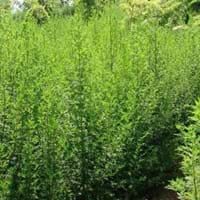Life Span
Annual
Perennial
Origin
Hybrid origin
Southeastern United States
Types
Not available
Not available
Habitat
Subtropical forests, Tropical Forests
Bluffs, Coastal Regions, Stream side, Woods
USDA Hardiness Zone
Not Available
5-9
Sunset Zone
Not Available
Not Available
Habit
Upright/Erect
Spreading
Flower Color
Not Available
White, Pink
Flower Color Modifier
Not Available
Bicolor
Fruit Color
Not Available
Brown
Leaf Color in Spring
Not Available
Green
Leaf Color in Summer
Not Available
Dark Green
Leaf Color in Fall
Not Available
Lemon yellow, Yellow green
Leaf Color in Winter
Not Available
Not Available
Leaf Shape
bipinnate
Palmate
Plant Season
Spring, Summer, Fall
Spring, Summer, Fall
Sunlight
Full Sun, Partial Sun
Full Sun, Partial Sun, Partial shade
Type of Soil
Loam, Sand
Clay, Loam, Sand
The pH of Soil
Acidic, Neutral
Acidic, Neutral, Alkaline
Soil Drainage
Well drained
Average
Bloom Time
Not Available
Summer, Late Summer
Tolerances
Drought, Salt
Salt, Wind
Where to Plant?
Ground, Pot
Ground, Pot
How to Plant?
Seedlings
Cuttings, Seedlings
Plant Maintenance
Medium
Low
Watering Requirements
Average Water Needs
Keep the Soil well drained, Requires regular watering
In Summer
Lots of watering
Lots of watering
In Spring
Moderate
Moderate
In Winter
Average Water
Average Water
Soil pH
Acidic, Neutral
Acidic, Neutral, Alkaline
Soil Type
Loam, Sand
Clay, Loam, Sand
Soil Drainage Capacity
Well drained
Average
Sun Exposure
Full Sun, Partial Sun
Full Sun, Partial Sun, Partial shade
Pruning
Remove damaged leaves, Remove dead branches, Remove dead leaves
Remove damaged leaves, Remove dead branches, Remove dead flowers, Remove dead leaves
Fertilizers
All-Purpose Liquid Fertilizer, Apply N-P-K
14-14-14 Fertilizer, Apply N-P-K, slow-release fertilizers
Pests and Diseases
Aphids, Gray leaf blight, Root rot
Edema, Powdery mildew, Verticillium Wilt
Plant Tolerance
Drought, Salt
Salt, Wind
Flowers
Insignificant
Showy
Flower Petal Number
Not Available
Single
Fragrant Bark/Stem
Yes
No
Foliage Texture
Not Available
Coarse
Foliage Sheen
Not Available
Matte
Attracts
Insects, Not Available
Butterflies, Hummingbirds
Aesthetic Uses
Not Used For Aesthetic Purpose
Cottage Garden, Showy Purposes
Beauty Benefits
Skin inflammation
Not Available
Environmental Uses
Air purification
Air purification, Wildlife
Medicinal Uses
Antioxidants, Fever, Inflammation, Malaria
Antirheumatic, Colic, constipation, Piles
Part of Plant Used
Leaves
Seeds
Other Uses
Medicinal oil, Oil is used for aromatherapy
Used for making soaps
Used As Indoor Plant
No
No
Used As Outdoor Plant
Yes
Yes
Garden Design
Foundation, Mixed Border, Rock Garden, Wall
Feature Plant, Foundation, Screening, Wind Break
Botanical Name
Artemisia annua
AESCULUS parviflora
Common Name
sweet wormwood, sweet annie, sweet sagewort, annual mugwort
bottlebrush buckeye, dwarf horse chestnut
In Hindi
Artemisia
Bottlebrush Buckeye
In German
Artemisia
Buckeye Putzer
In French
Artemisia
Bottlebrush Buckeye
In Spanish
Artemisia
bottlebrush Buckeye
In Greek
Αρτεμίσια
bottlebrush Buckeye
In Portuguese
Artemisia
Bottlebrush Buckeye
In Polish
Artemisia
Bottlebrush Buckeye
In Latin
Artemisia
bottlebrush Buckeye
Phylum
Magnoliophyta
Magnoliophyta
Class
Magnoliopsida
Magnoliopsida
Order
Asterales
Sapindales
Family
Asteraceae
Hippocastanaceae
Clade
Angiosperms, Asterids, Eudicots
Angiosperms, Eudicots, Rosids
Tribe
Anthemideae
Not Available
Subfamily
Asteroideae
Hippocastanoideae
Properties of Artemisia and Bottlebrush Buckeye
Wondering what are the properties of Artemisia and Bottlebrush Buckeye? We provide you with everything About Artemisia and Bottlebrush Buckeye. Artemisia doesn't have thorns and Bottlebrush Buckeye doesn't have thorns. Also Artemisia does not have fragrant flowers. Artemisia has allergic reactions like Pollen and Bottlebrush Buckeye has allergic reactions like Pollen. Compare all the properties and characteristics of these two plants. Find out which of these plant can be used as indoor plant. If you are interested to decorate your house and garden, find out aesthetic uses, compare them and select the plant which will beautify your surrounding. Along with beautification, try comparing medicinal and edible uses of Artemisia and Bottlebrush Buckeye and you can choose the plant having best and most benefits.
Season and Care of Artemisia and Bottlebrush Buckeye
Season and care of Artemisia and Bottlebrush Buckeye is important to know. While considering everything about Artemisia and Bottlebrush Buckeye Care, growing season is an essential factor. Artemisia season is Spring, Summer and Fall and Bottlebrush Buckeye season is Spring, Summer and Fall. The type of soil for Artemisia is Loam, Sand and for Bottlebrush Buckeye is Clay, Loam, Sand while the PH of soil for Artemisia is Acidic, Neutral and for Bottlebrush Buckeye is Acidic, Neutral, Alkaline.
Artemisia and Bottlebrush Buckeye Physical Information
Artemisia and Bottlebrush Buckeye physical information is very important for comparison. Artemisia height is 150.00 cm and width 150.00 cm whereas Bottlebrush Buckeye height is 180.00 cm and width 180.00 cm. The color specification of Artemisia and Bottlebrush Buckeye are as follows:
Artemisia flower color: Not Available
Artemisia leaf color: Not Available
Bottlebrush Buckeye flower color: White and Pink
- Bottlebrush Buckeye leaf color: Green
Care of Artemisia and Bottlebrush Buckeye
Care of Artemisia and Bottlebrush Buckeye include pruning, fertilizers, watering etc. Artemisia pruning is done Remove damaged leaves, Remove dead branches and Remove dead leaves and Bottlebrush Buckeye pruning is done Remove damaged leaves, Remove dead branches, Remove dead flowers and Remove dead leaves. In summer Artemisia needs Lots of watering and in winter, it needs Average Water. Whereas, in summer Bottlebrush Buckeye needs Lots of watering and in winter, it needs Average Water.





